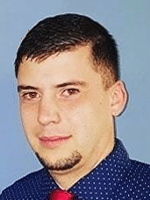By Michael R. Cole II, DC, MS

The residency is a one-year program from July 1-June 30. The global COVID-19 pandemic has had a major impact on the healthcare system and has changed how we provide care to patients; the VA chiropractic residency is no exception. While the annual residency cycle started as scheduled on July 1, 2020, with the 2021 class of chiropractic residents, our resident class will surely have a unique experience with unique challenges and opportunities.
The Impact of COVID on the Residency
At VA St. Louis Health Care System, where I am currently a resident, many VA services were temporarily closed or transitioned to telehealth either through phone or virtual video appointments. This is true throughout most VA systems. Currently different services are gradually returning and offering in-person visits for patient care but continue to supplement with telehealth. The chiropractic clinic was temporarily closed for in-person visits and transitioned to telehealth visits. We are gradually returning to in-person visits, and currently are at 50 percent of daily capacity. We continue to supplement these visits through telehealth.
Rarely, if ever, do you think of chiropractic practice and telehealth together, as chiropractic is primarily a manual “hands-on” therapy. However, many services provided by chiropractic physicians such has home exercise plans (HEP) and overall case management can be accomplished via video appointments. Even physical exams can be conducted through a live video feed. This has been both a unique challenge and opportunity as a young resident. Its challenging because I was never taught how to use telehealth while in school, but also a great opportunity. My residency cohort also has a great opportunity as we are some of the first chiropractors being trained in telehealth.
Continuity of care is always important, and this is especially true when dealing with chronic pain patients. Telehealth services allow us to maintain continuity of care in between in-person visits, or when in-person visits are not available due to clinic backlog, clinic closures or if the patient has an increased risk for COVID-19. Many chronic pain patients often suffer from overlapping complex mental health issues, which is especially true within VA. While social distancing may be needed to slow the spread of COVID-19, withdrawal of care can lead to patients feeling isolated and helpless. Telehealth helps to close the gap by increasing access to care, providing self-assurance, and connecting with veterans’ others points of service, as needed.
In addition to training and use of telehealth, some clinical rotations, particularly within Whole Health, have also been accomplished through telework. VA St. Louis, a flagship for Whole Health within VA, has done a great job transitioning much of its Whole Health offerings to virtual appointments. Yoga, tai chi and mindfulness classes that would normally meet in person are now being conducted through virtual telehealth video appointments. As a chiropractic resident within the Whole Health system, I have had the opportunity to do rotations through various virtual Whole Health groups including tai chi, mindfulness and Battlefield Acupressure, along with classes such as anti-inflammatory diet and Whole Health orientation. Not only do these virtual services improve continuity of care but many of the groups have also taken a role as support groups for the veterans. Additionally, I have had the opportunity to rotate with internal medicine residents who are all new to VA in the urgent-care clinic. This has provided many opportunities for them to understand the importance of Whole Health and chiropractic care as they begin their residency program at VA.
While many of the veterans say they do prefer the in-person groups, they are thankful for the virtual video groups. Many take the time to offer support to one another and it’s a way for them to socialize, as many limit in-person contact with others due to the risk of COVID-19 and their related comorbidities.
Aside from decreased patient visits, limited currently to 50 percent of capacity within the VA St. Louis chiropractic clinic, and the training and utilization of telehealth services, the residency has been largely unaffected by COVID-19. However, working within a large integrative hospital setting such as VA during a global pandemic has been unique in general. Every employee, patient, and visitor undergoes screening daily prior to being allowed to enter the building and there are separate entrances for employees and patients/visitors. Also, appropriate PPE such as surgical masks, face shields, and goggles are required during patient visits and while walking around the premises. There is increased sanitation throughout the day of our treatment rooms as well as areas in and around the building. I do feel some added stress during my residency related to COVID-19 and the risks associated with working within a vulnerable patient population and hospital setting, however, I feel family and friends are more concerned about my possible exposure to COVID, than I am myself. I believe the VA has done a great job implementing screening protocols to ensure the safety of both the staff and our veteran patients.
Adapting on a Personal Level
One of the biggest challenges that I have faced with the residency is not directly related to my work within the residency itself. I relocated from Florida, where I completed my student clerkship, to my hometown of Ohio and now to St. louis for the residency. The biggest challenge I have had is moving to a new state and city without the benefit of knowing anyone in the area during a global pandemic, when social distancing and wearing of masks is required. Meeting people and developing a social life in a new city while abiding by these recommendations continues to be a challenge. I am, however, grateful to have family within three hours and visit them frequently on the weekends. My experience two months into the residency has been positive. I look forward to continuing to develop as a young chiropractic clinician and a young man through the VA Chiropractic Residency.
